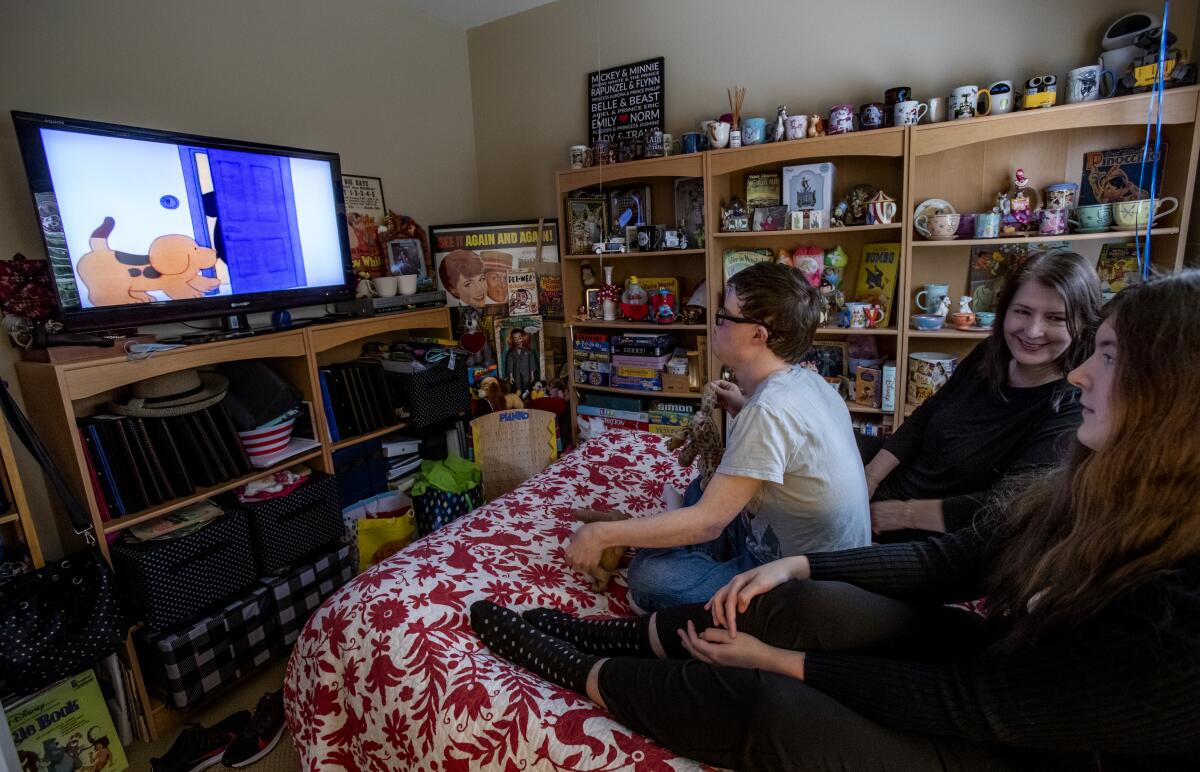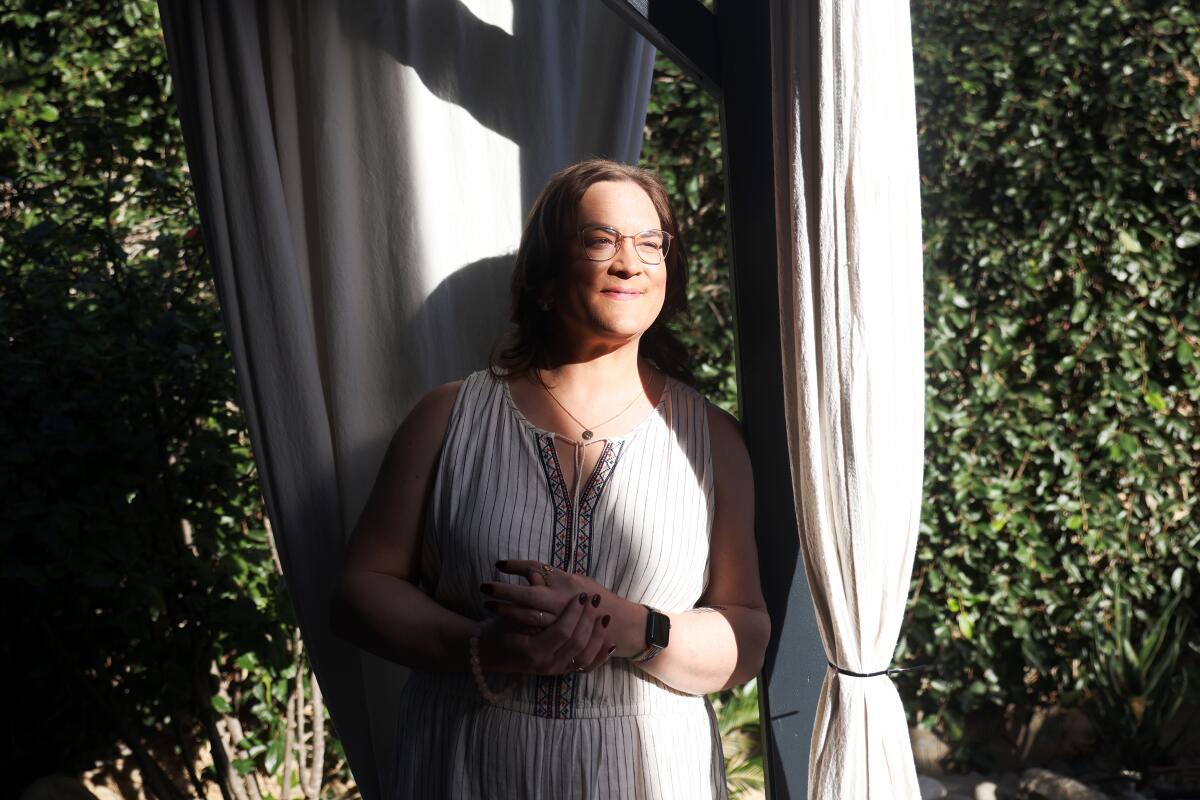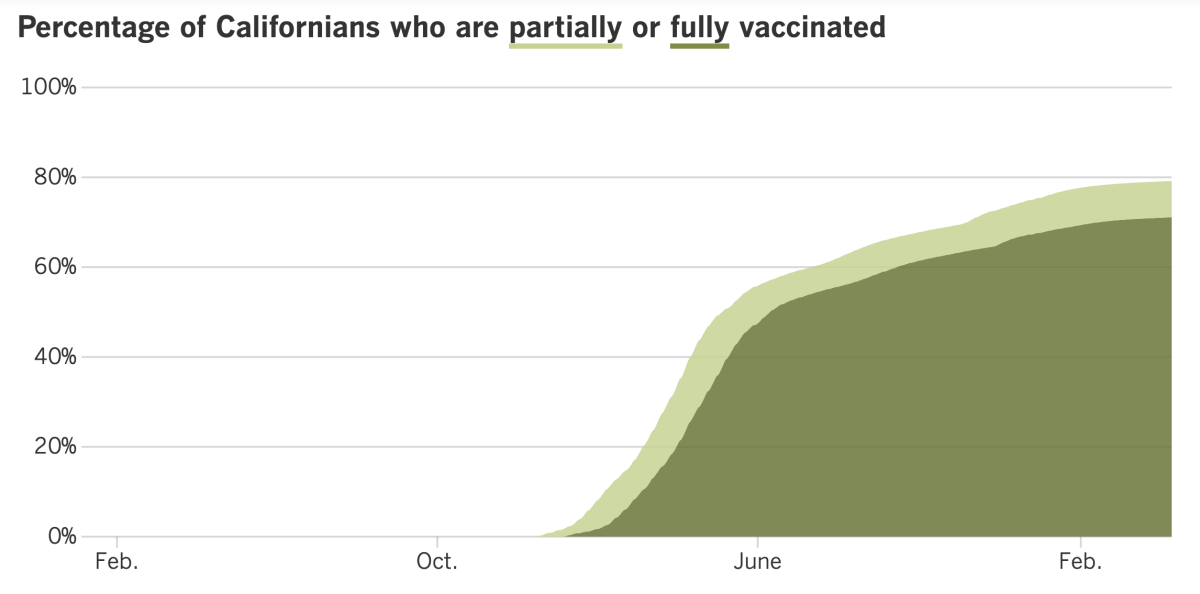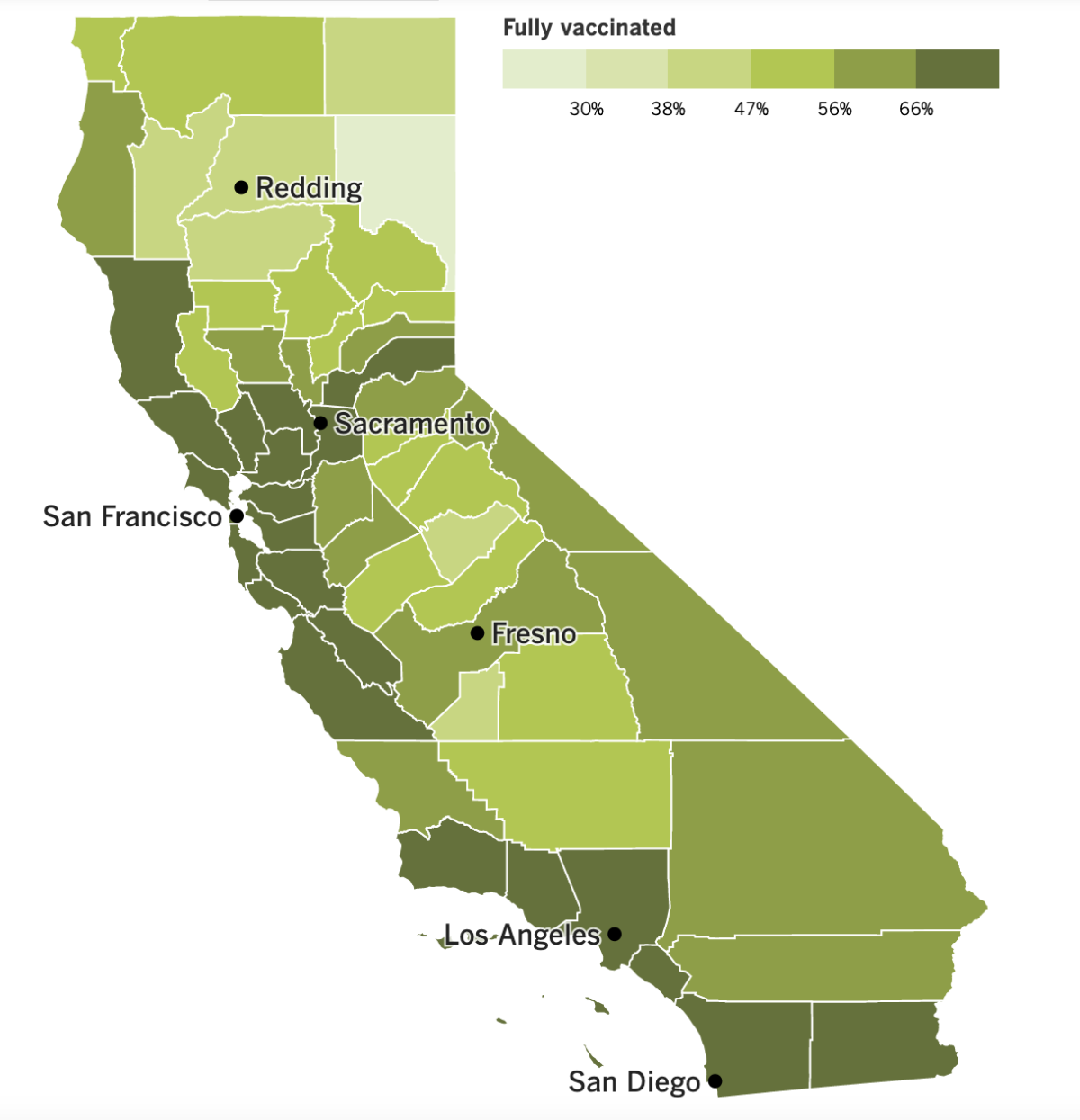Coronavirus Today: When lives feel ‘disposable’
- Share via
Good evening. I’m Karen Kaplan, and it’s Tuesday, April 12. Here’s the latest on what’s happening with the coronavirus in California and beyond.
For many of us, the loosening of pandemic restrictions has brought a long-awaited sense of relief. The coronavirus isn’t gone, and neither is the danger. But being able to move through the world without having to wear a mask the entire time, flash your digital vaccination record everywhere you go, or swab your nostrils on a regular basis are all tangible reminders that, eventually, life will go back to normal.
And then there are people like Kaia Brooke, for whom these signs of “progress” are potentially mortal threats.
Brooke has chronic illnesses — including a metabolic disorder that requires iron infusions — that increase her risk of developing a serious case of COVID-19. She is one of the roughly 7 million immunocompromised Americans who don’t have the luxury of letting down their guard.
“We can’t move on like everyone else has been doing,” she told my colleague Emily Alpert Reyes.
One of the hardest parts for Brooke is that the more she sees other people enjoy their new freedoms, the more she is forced to retreat. The 24-year-old Monrovia resident spends much of her time at home reading, resting in bed and playing video games.
Sometimes “it’s hard to shake the feeling of our lives feeling disposable,” she said.

That’s even more true when Dr. Rochelle Walensky, the head of the Centers for Disease Control and Prevention, calls it “really encouraging” that 75% of the people who died of COVID-19 despite being fully vaccinated had four or more preexisting health problems and thus were “unwell to begin with.” (She apologized a few days later.)
It’s not just that rules about vaccines, masks and social distancing have been weakened or abandoned. It’s that those changes were made without first ensuring that immunocompromised people were able to get their hands on Evusheld, an antibody treatment designed to buttress their defense against COVID-19.
On top of that, government programs to test and treat people are being scaled back as the super-contagious BA.2 version of Omicron expands its footprint in the U.S. The public health priority has shifted from reducing coronavirus transmission — the key factor for people like Brooke — to minimizing the strain on the healthcare system.
“We’re doing all the things that don’t protect people with disabilities,” said Bethany Lilly, a senior director at the Arc, an organization that advocates for people with intellectual and developmental disabilities.
The result is that people who are immunocompromised will have to do more to protect themselves, since the public as a whole is doing less. They’ll have to keep wearing masks, stay up to date on their immunizations, and be a lot more judicious about their public outings, said Dr. William Schaffner, medical director of the National Foundation for Infectious Diseases.
“The initiative will have to remain with the individuals who are affected and those closest around them,” Schaffner said. “Society has moved on.”
So Brooke and her family will keep holding off on a trip to the Academy Museum of Motion Pictures, where they hope to catch the Hayao Miyazaki exhibit before it closes in early June. A visit to Disneyland will require even more patience.
Christine Mitchell can sympathize. She’s a public health researcher and advocate with the Public Health Justice Collective in the Bay Area who happens to have a connective tissue disorder.
“I get it. People are tired. People are annoyed. People don’t want to wear masks,” Mitchell said. “But my life — and the lives of disabled people and immunocompromised people and all the people who are at high risk — is worth more than someone’s convenience.”
By the numbers
California cases and deaths as of 4:40 p.m. on Tuesday:

Track California’s coronavirus spread and vaccination efforts — including the latest numbers and how they break down — with our graphics.
Faith in the time of COVID-19
Sometimes it takes a pandemic to face the truth. In Esther Loewen’s case, it’s that she’s transgender.
Coming out was a scary proposition. Loewen feared the truth would cost her both her marriage and her career as a Seventh-Day Adventist pastor. But as she struggled with thoughts of suicide in the fall of 2020, she realized the time had come to share her secret.
“I’m afraid I might be trans,” Loewen told her wife, Paige Wisbey Loewen. Paige’s reply: “I’m not going anywhere.”
My colleague Marisa Gerber told Loewen’s story as part of a trio of profiles examining how people’s relationship to their faith evolved during the pandemic. All three journeys are insightful, though Loewen’s is the most striking.
Loewen, who is 40, wrote on her personal blog that she had experienced gender dysphoria since childhood. For a rough idea of how that feels, she likened it to being forced to wear ill-fitting shoes that are not only painful but force you to move unnaturally. To make matters worse, all you hear from the people around you is how these terrible shoes are a perfect fit.
She dropped hints about it to her wife before their wedding. She was jealous when her wife was pregnant with their two sons. She knew it when her fellow pastors made “uncharitable and often downright cruel comments about LGBTQ people” without realizing she was one of them.
The internal conflict reached new depths during the pandemic’s first summer. Then words spoken by another pastor guided her away from the suicidal ledge and pointed her toward a path of “honest courage,” Loewen wrote.

It would take more than another year for her to come out, but in some ways, the weirdness of pandemic time made things easier. As Gerber explained, “For the first time ever, she was isolated from the social pressures and fears that had prevented her from transitioning.”
Since she was delivering her sermons online instead of in person, she was able to start growing out her hair and paint her toenails without attracting public attention. Her beard stayed but was closely cropped. Thanks to Zoom, she was able to talk with other transgender Christians in support groups.
She didn’t want to start taking hormones without some sign of God’s blessing. It came in January 2021 during a retreat attended by church leaders. After several hours of solitary prayer, Loewen rounded a corner in an oak preserve and laid eyes on hundreds of monarch butterflies — a symbol of transition.
“It shifted from being like, ‘Can I do this?’ to ‘I have to do this in order to be faithful to God,’” she told Gerber.
She knew the Seventh-Day Adventist church did not welcome LGBTQ people into its leadership. She loved her job and wouldn’t lie outright to keep it, but she also felt justified in keeping her private life private.
A few months later, she told her colleagues she was trans and suggested the church reassign her to a more liberal area. But that wasn’t an option, and she had to resign. (She is now studying to be a therapist.)
Despite this, Loewen told Gerber she’s never felt closer to God. Her two school-age sons accept her and call her “Mapa.” And her wife has lived up to her promise.
Paige Wisbey Loewen explained her feelings in a Facebook post last fall:
“Very simply,” she wrote, Esther “is my person. She always has been and always will be. The thought of leaving has never even crossed my mind. We love each other and have built a beautiful family and life together. There is no one on earth I would rather spend my life with. This hasn’t changed at all.”
California’s vaccination progress


See the latest on California’s vaccination progress with our tracker.
Your support helps us deliver the news that matters most.
In other news ...
It’s time for a pop quiz: After Los Angeles County students were given the option to remove their masks in school classrooms, did coronavirus cases (a) increase (b) decrease or (c) remain the same?
If you guessed (a), give yourself a gold star.
Schools in the county reported 14 new coronavirus outbreaks in the week that ended Thursday, up from four the week earlier. That’s the highest number county health officials have seen since early February, when the Omicron surge was still going strong.
One of those 14 outbreaks affected at least 60 people, making it “one of the largest outbreaks we’ve ever had at a school since the beginning of the pandemic,” said L.A. County Public Health Director Barbara Ferrer. It was fueled by the hypercontagious BA.2 version of Omicron, but the fact that indoor mask rules were lifted was certainly a factor, she said.
“Why would we see more outbreaks? Well, it’s because some of the other protections that we had in place are no longer there,” she said.
It’s not just schools seeing case numbers climb. Over the week that ended Monday, L.A. County reported 67 new coronavirus cases for every 100,000 residents, a 23% increase from the previous week. Orange County’s weekly rate of 30 new cases per 100,000 residents is 12% higher than it was a week earlier. And San Francisco’s recent weekly rate of 102 new cases per 100,000 is up 6% week-to-week.
Statewide, California was recently averaging 50 new cases per week for every 100,000 residents. That figure is 9% higher than it had been a week earlier.
Health officials are bracing for the numbers to keep rising, especially as people travel for spring break or to celebrate holidays such as Easter, Ramadan or Passover. Yet despite these fears, L.A. County has reduced the number of free community testing sites by 25.
The reason for the pullback is a political stalemate in Washington, D.C., over a new pandemic funding bill. The federal government stopped providing money to offer coronavirus tests to uninsured people, and it’s no longer reimbursing health providers seeking reimbursement for such tests.
Despite these setbacks, the county still has 200 free testing sites listed on its website.
“We will keep doing this as long as possible,” said Dr. Christina Ghaly, director of the county’s Department of Health Services. That commitment will cost L.A. County about $5 million to $10 million to run tests for people without health insurance.
Los Angeles city officials are making plans to reopen City Hall to the public for the first time in more than two years. The downtown building has been closed since March 2020, but visitors will be welcome once again starting May 4. To enter, they’ll have to wear masks and show proof of vaccination or a recent negative coronavirus test.
Speaking of vaccine requirements, a federal appeals court in New Orleans has upheld President Biden’s requirement that all federal government employees be vaccinated against COVID-19. The administration argued that just like a private-sector CEO, the president had the authority to insist that members of his workforce be vaccinated.
The 2-1 ruling by a panel of the U.S. 5th Circuit Court of Appeals reversed a lower court order by a judge in Texas who had issued a nationwide injunction against Biden’s vaccine mandate in January. The appeals court ordered that a lawsuit challenging the mandate be dismissed.
In Washington, the House of Representatives has approved a COVID-19 assistance bill that would add $42 billion to a fund offering tax-free grants to restaurants that lost revenue due to pandemic shutdowns. The bill also earmarks $13 billion to other businesses struggling to get back on their feet. It’s not clear how the legislation will fare in the Senate.
Meanwhile, the slimmed-down Senate bill aimed at funding the U.S. coronavirus response is being slammed by health experts because it contains almost no money for curbing the virus beyond America’s borders. The move is penny-wise but pound-foolish, critics say, because suspending aid to poorer countries could facilitate the kind of unchecked viral transmission that breeds worrisome new variants.
The U.S. has funded vaccination campaigns in dozens of countries, among other initiatives. Those efforts could come to a halt.
“This virus knows no borders, and it’s in our national interest to vaccinate the world and protect against possible new variants,” said Jeff Zients, the outgoing leader of the White House COVID-19 task force.
In related news, a report from the World Health Organization estimates that up to 65% of people in Africa had been infected with the coronavirus since the pandemic began. The assessment is based on reviews of 151 studies as well as blood samples taken between January 2020 and December 2021.
If the new figure is correct, it means the continent has seen about 800 million infections. That number is 100 times higher than the official tally of about 8 million.
Let’s move on to China, where some of Shanghai’s 25 million residents were allowed to leave their homes today, two weeks after an abrupt shutdown forced people to hunker down without adequate supplies of food and medicine. Members of the public have been fuming over the extreme measures, which also include the use of crowded quarantine facilities that forced children to be separated from their parents.
People in neighborhoods that had no new cases for at least two weeks were allowed to leave their homes and visit other neighborhoods that have also been virus-free for the past two weeks. In addition, people in neighborhoods that haven’t had a new case in the past week got permission to leave their homes, but not their neighborhoods. It’s unclear how many people were affected by the moves.
More than 200,000 coronavirus cases have been reported in the city’s current wave of infections. Though the government hasn’t attributed any deaths to COVID-19, some media outlets have reported an outbreak of infections and deaths at the city’s largest care facility for the elderly. Vaccination rates among China’s senior citizens lag behind other age groups, and they’d be particularly vulnerable if the lockdown were eased.
Germany is having its own vaccine problems — it’s on track to throw away 3 million expired doses by the end of June. The country is only administering about 33,000 shots per day, down from more than 1 million on its best days in December.
“We have more vaccine available at the moment than is being used and than we can donate,” a spokesman for the country’s health ministry said. The situation looked worse before people figured out that Comirnaty, the vaccine made by Pfizer and BioNTech, could be stored for longer than previously thought. Prior to that realization, the country was looking at discarding or destroying 10 million doses.
But the most unusual vaccine story of the week comes from San Francisco, where a naturopathic doctor pleaded guilty to selling hundreds of fraudulent CDC vaccination cards, along with instructions for filling them out so it looked like their owners had received SpikeVax, the Moderna vaccine.
Juli A. Mazi of Napa also pleaded guilty to selling homeopathic pellets she claimed would provide “lifelong immunity to COVID-19.” Customers were told the pellets contained small amounts of the coronavirus and would stimulate an antibody response, federal prosecutors said.
“This doctor violated the public’s trust and reliance on healthcare professionals — during a time when integrity was needed most,” said Asst. Atty. Gen. Kenneth A. Polite Jr.
Mazi will be sentenced in late July.
Your questions answered
Today’s question comes from readers who want to know: How can I tell if I have COVID-19 or just normal allergies?
This is something that’s sure to come up a lot now that both the BA.2 subvariant and seasonal allergies are on the upswing. Luckily, my colleague Jon Healey is one step ahead of you.
The two conditions have overlapping symptoms, including coughing, sneezing, a runny nose, sore throat, headache and fatigue.
But some symptoms are associated with only one of these ailments. Shortness of breath, fever, chills, body aches, and new loss of taste or smell are all characteristic of COVID-19 but uncommon for those with allergies. Likewise, allergy sufferers are very familiar with itchy or watery eyes, and that’s not a problem for COVID-19 patients.
Dr. Dean Metcalfe, a researcher at the National Institute of Allergy and Infectious Diseases, suggests you consider your symptoms in context. If you’re going through tissue boxes like there’s no tomorrow, ask yourself whether you usually have allergies at this time of year, and if so, whether your symptoms are worse than usual. You should also think about whether you’ve recently spent time with someone who has (or just got over) a case of COVID-19 or the flu.
Here’s something to watch out for: If you’re fully vaccinated, you’re less likely to develop the COVID-only symptoms. That can make it more difficult to tell whether it’s COVID-19 or allergies that’s making you feel miserable.
If you’re still unsure what ails you, you can get some clarity by taking a COVID-19 test at home or getting one at a community testing site.
“Always err on the side of testing,” Dr. Rita Kachru, an allergy and immunology specialist at UCLA, told Healey.
We want to hear from you. Email us your coronavirus questions, and we’ll do our best to answer them. Wondering if your question’s already been answered? Check out our archive here.
The pandemic in pictures

The man in the photo above is Gary Evans, father of my colleague Marissa Evans. It was taken at Mt. San Jacinto State Park on Dec. 18, 2021, just six weeks before he died of COVID-19 in the ICU of a San Diego-area hospital.
Evans is both a devoted daughter and a reporter who covers healthcare and communities of color. So after her father’s death, she wrote an introspective and insightful essay about how our health system treats Black men. Here’s an excerpt:
Death is inevitable, but Black boys and men should not have to live their lives assuming their humanity is debatable. Part of the problem is Black men often wait for care until they’re in dire predicaments, no matter how many people encourage them to do otherwise. We can partially explain this away with many Black men being uninsured or not having a regular doctor.
But we also must recognize how many Black men don’t seek medical care because for generations they have been told verbatim or through societal and political inaction that asking for help or acknowledging emotional or physical pain are signs of weakness. Too often, it’s only when their livelihood or physical well-being is at stake that they start considering their wellness.
Saving Black men in America would require a herculean effort by systems and institutions that seems unfathomable in these times. How much longer could they live if they knew the world wanted them to have openly human experiences of breathing, crying, grieving, being cared for and being heard?
Evans’ piece examines the racial disparities in COVID-19 outcomes in a way we rarely see. Please give it a read (or a listen).
Resources
Need a vaccine? Here’s where to go: City of Los Angeles | Los Angeles County | Kern County | Orange County | Riverside County | San Bernardino County | San Diego County | San Luis Obispo County | Santa Barbara County | Ventura County
Practice social distancing using these tips, and wear a mask or two.
Watch for symptoms such as fever, cough, shortness of breath, chills, shaking with chills, muscle pain, headache, sore throat and loss of taste or smell. Here’s what to look for and when.
Need to get a test? Testing in California is free, and you can find a site online or call (833) 422-4255.
Americans are hurting in various ways. We have advice for helping kids cope, as well as resources for people experiencing domestic abuse.
We’ve answered hundreds of readers’ questions. Explore them in our archive here.
For our most up-to-date coverage, visit our homepage and our Health section, get our breaking news alerts, and follow us on Twitter and Instagram.




